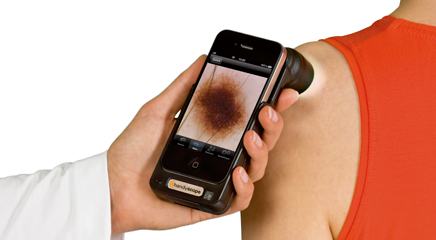NURSING NOTES
• Smart phones or tablets promise to revolutionize clinical diagnosis and patient care, allowing clinicians to quickly consult pain medication doses or to conduct ultrasound or echocardiogram exams.
• Mobile melanoma exam apps are being used in consultations between nonspecialist clinicians and dermatologists, but may pose some challenges.
• The use of teledermatology and mobile teledermatology has proven to be extremely useful in providing dermatologic care and consultations to medically underserved areas.
• Experts are questioning the validity of the app algorithms that were created to analyze skin/moles.
• Incorrect readings of skin scan apps by nonspecialist clinicians can delay a full body skin exam or discourage a patient from seeking an exam at all.
• A lot of variability exists between skin apps.
Mobile medical “apps” promise to revolutionize diagnostic medicine and patient care, turning ordinary smart phones into stethoscopes and lightweight diagnostic imaging machines. But, experts tell Chemotherapy Advisor that new consumer-targeted cancer screening apps may put patients at risk.
Clinicians enjoy a growing arsenal of downloadable applications and lightweight peripheral attachments that turn ordinary smart phones and tablet computers into powerful, portable diagnostic tools. For thousands of early adopters of these technologies, inexpensive apps are replacing tools as basic as the physician’s stethoscope. They promise to revolutionize clinical diagnosis and patient care, allowing clinicians to quickly consult pain medication doses, or to conduct ultrasound or echocardiogram exams–all using a smart phone or tablet.1,2
In the near future, portable computing and communications technology will allow a patient to “take a video of a rash on your foot and get a diagnosis later that afternoon without making a doctor’s appointment,” US Department of Health & Human Services Secretary Kathleen Sebelius predicted in December. “This takes the biggest technology breakthrough of all time and uses it to address our greatest national challenge.”1
Already, much anticipated mobile melanoma exam apps are being used in consultations between nonspecialist clinicians and dermatologists. Handheld dermatoscopes with dedicated iPhone software apps allow physicians to photograph, store, and share magnified images of suspicious moles and suspected melanomas on patients’ skin. This permits nonspecialist physicians in rural settings to conduct skin cancer screenings and refer suspicious lesions to qualified dermatologists in other cities for follow-up.2-5
There are even video education apps to help clinicians teach women how to do breast cancer self-exams or to help foster patients’ understanding of smoking cessation and cancer awareness.2
“The use of teledermatology and mobile teledermatology has proven to be extremely useful in providing dermatologic care and consultations to medically underserved areas,” Sonia Lamel, MD, a dermatology research fellow at the University of California, San Francisco, told Chemotherapy Advisor. “Any tool encouraging and educating about self-skin examination is a good thing.”
But since last year, risk-assessment apps like the melanoma “Skin Scan” app produced by a Romanian company have started to hit the market. These diagnostic apps are sold directly to consumers and use algorithms that analyze the contours and characteristics of a suspicious mole and describe its potential hazard to a patient. Images can be stored so a suspect mole’s changes can be tracked. And that, some experts believe, may be reason for concern.6
Maral Skelsey, PhD, a clinical assistant professor of dermatology at Georgetown University in Washington, DC, told Chemotherapy Advisor, “To look at a mole and determine risk for cancer is probably the biggest challenge in dermatology. It takes every tool we have available to us–ears, touch to palpate, patient history — their history of sun exposure and family history of cancer– and even the gestalt that comes from experience. We look at all of these things and say, this particular mole is an ugly duckling.”
Dr. Skelsey also noted, “It is not entirely clear how these algorithms were developed and tested. There are not enough data or long-term studies available to say melanoma risk assessment apps can save lives.” She also cautioned, “Not knowing the foundation of this technology is very troubling; it could be harmful. Are we giving folks a false sense of security? It seems more like a party trick than a really useful and helpful component of preventive care.”
Dr. Skelsey emphasized teledermatology is no substitute for periodic total body skin exams. One 2011 study, for example, found that only 22% of lesions prompting referrals were cancerous and only 59% of cancers were identified in the lesions prompting referrals; the rest were incidentally identified by dermatologists during exams prompted by concern for other skin lesions.4
